Cold Hoops - Poly Low Tunnels for Fall Season Extension - A Successful Experiment
When I moved into this home for the winter I inherited a garden from the previous tenants. There was not much left in it aside from a handful of tomatoes and peppers that didn't get harvested. Still it was something we could harvest right away which was pretty cool.
It was late September and I ambitiously decided to seed some veggies for late fall harvest and early spring harvest using poly low tunnels.
Coming from a warmer climate in Southern California I am not used to a colder (zone 6a) climate, so this was a great opportunity to dig in and learn.
I was inspired by Eliot Coleman's The Winter Harvest Handbook. Eliot states that covering a crop with a hoop or greenhouse gives it the advantage of being 1 1/2 zones warmer. And on top of that if you do a cover within a cover you can double that for 3 zones increase. That's a lot!
I opted to try one cover and see what I could do. I knew I was behind the ideal fall planting time already, since the days were already getting shorter and nights were getting colder. So the day after I moved in, I immediately sowed seeds in two beds. I didn't even spend much time prepping the beds other than moving mulch out of the way. I just wanted seeds in the ground ASAP.
I ended up planting carrots, spinach, beets, bok choy, asian greens mix, chard, arugula and onions.
I got hoops up and plastic on top of them within 2 days after sowing the seeds.
I used pvc and galvanized steel hoops that were lying around this farm unused. And I was loaned a huge sheet of 6 mil poly that was being saved as a backup for the greenhouse. It turns out that this big square sheet of poly was way too cumbersome to manage without cutting it up which we didn't want to do. So I spent $60 and ordered a new 3 mil poly that was 20'x55'. This let me cut it in half and get two hoop covers for the two 50' beds that I direct seeded.
Once I received the new plastic the 6mil was swapped out and I was able to secure the plastic to the hoops. I secured the plastic using string crisscrossing across the plastic similar to the method described here. In my research I also learned that it's not good to have pvc coming in contact with the poly sheets because it can react and cause UV damage decreasing its lifetime. So I swapped out the pvc for more metal hoops. Luckily I was able to scavenge just the right amount.
This is what it looked like with the new plastic.
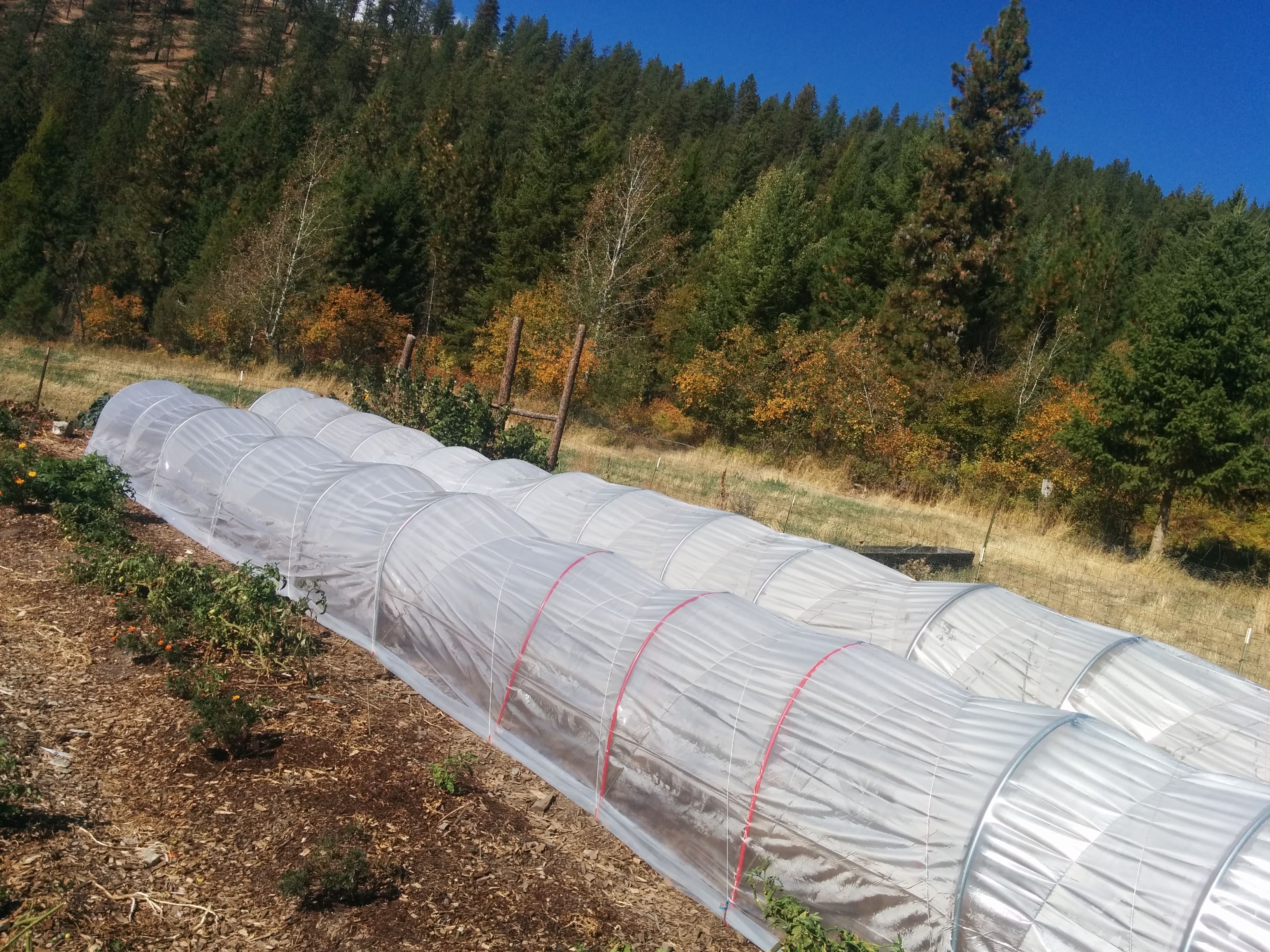
With the hoops up, germination was incredibly fast. They worked so well that on sunny days the temperature was always much warmer. Even on overcast days there was some gain. Within a few weeks I was already thinning bok choy, enough for several meals.
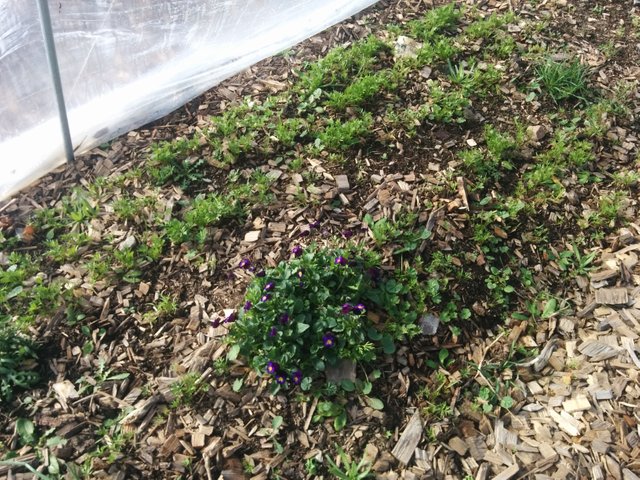
Well it worked pretty good until the strong winds came. My hoops were anchored, but not well enough and not enough anchors. Half of each hoop was flopping in the wind- what a mess. After some time getting things back in place and well anchored, the hoops have been amazingly solid.
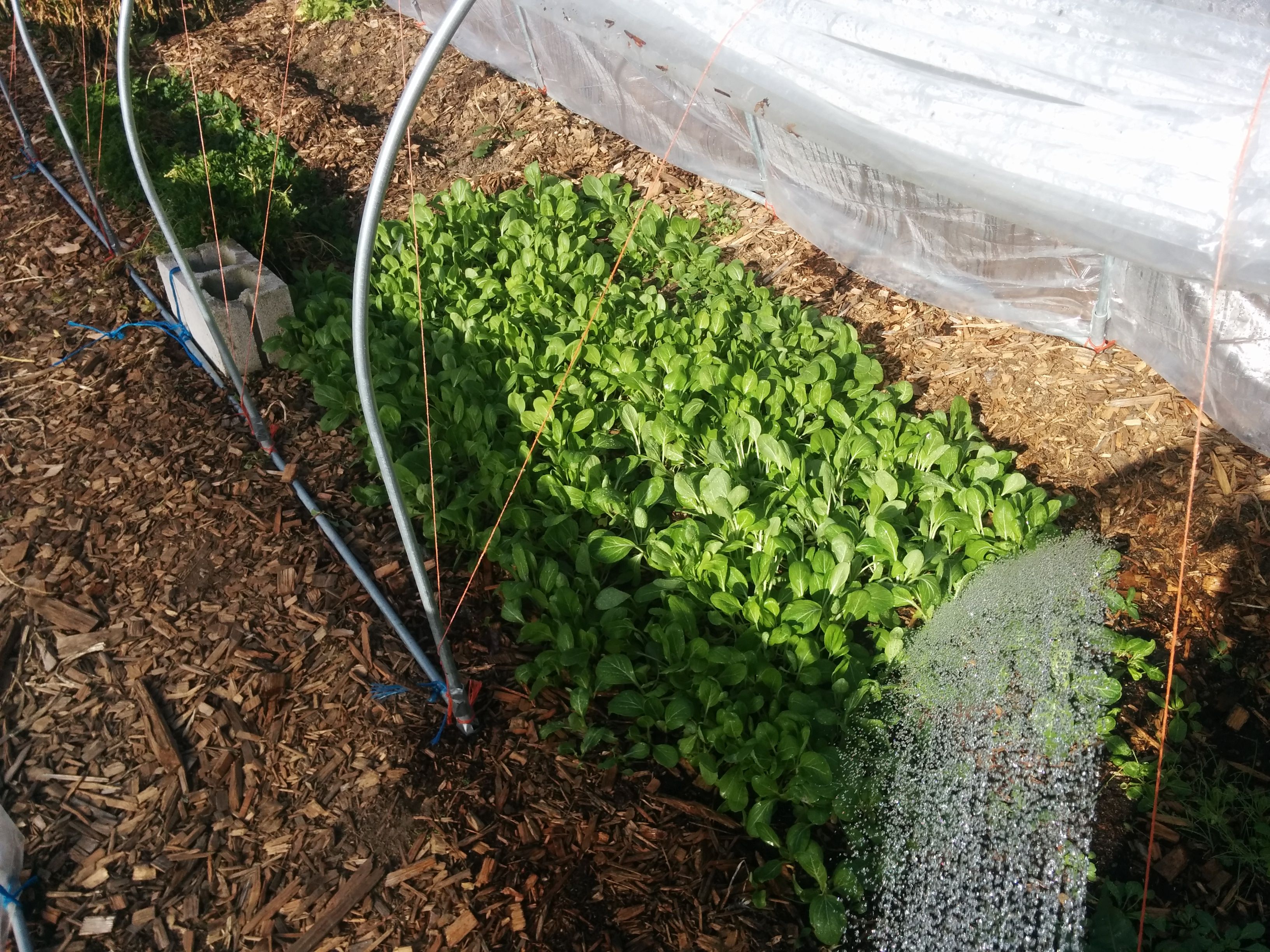
After a second thinning of the bok choy I had so much harvested that I was able to eat several meals and freeze quite a bit. I'm about to do a third and final thinning. The growth has slowed down so much now that I can't expect them to continue until next spring, if they survive that long. And most likely they won't without heat when it gets down into the single digits.
Out of all the veggies I planted the bok choy was the clear winner in terms of quick germination, growth rate and most harvest. Spinach was right behind the bok choy. And while I didn't get as many spinach plants they also grew relatively quickly. The carrots, beets and onions are much slower. But the great thing is that I will have really early spring carrots and onions, and LOTS of them! In the meantime I can still harvest green onions right now and put them on my salads and baked potatoes.
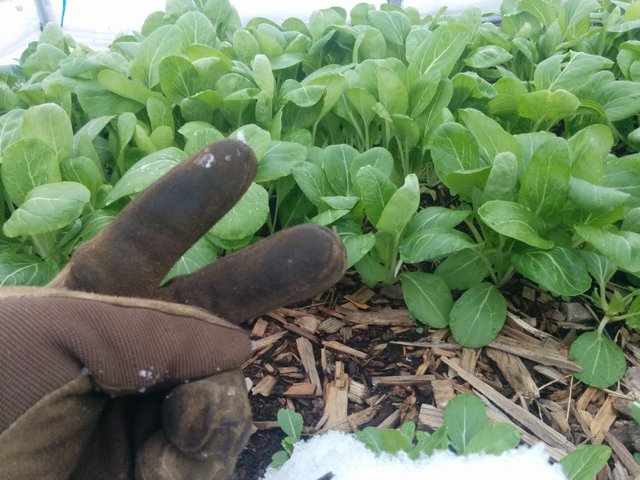
This is what the hoops look like now in mid-December
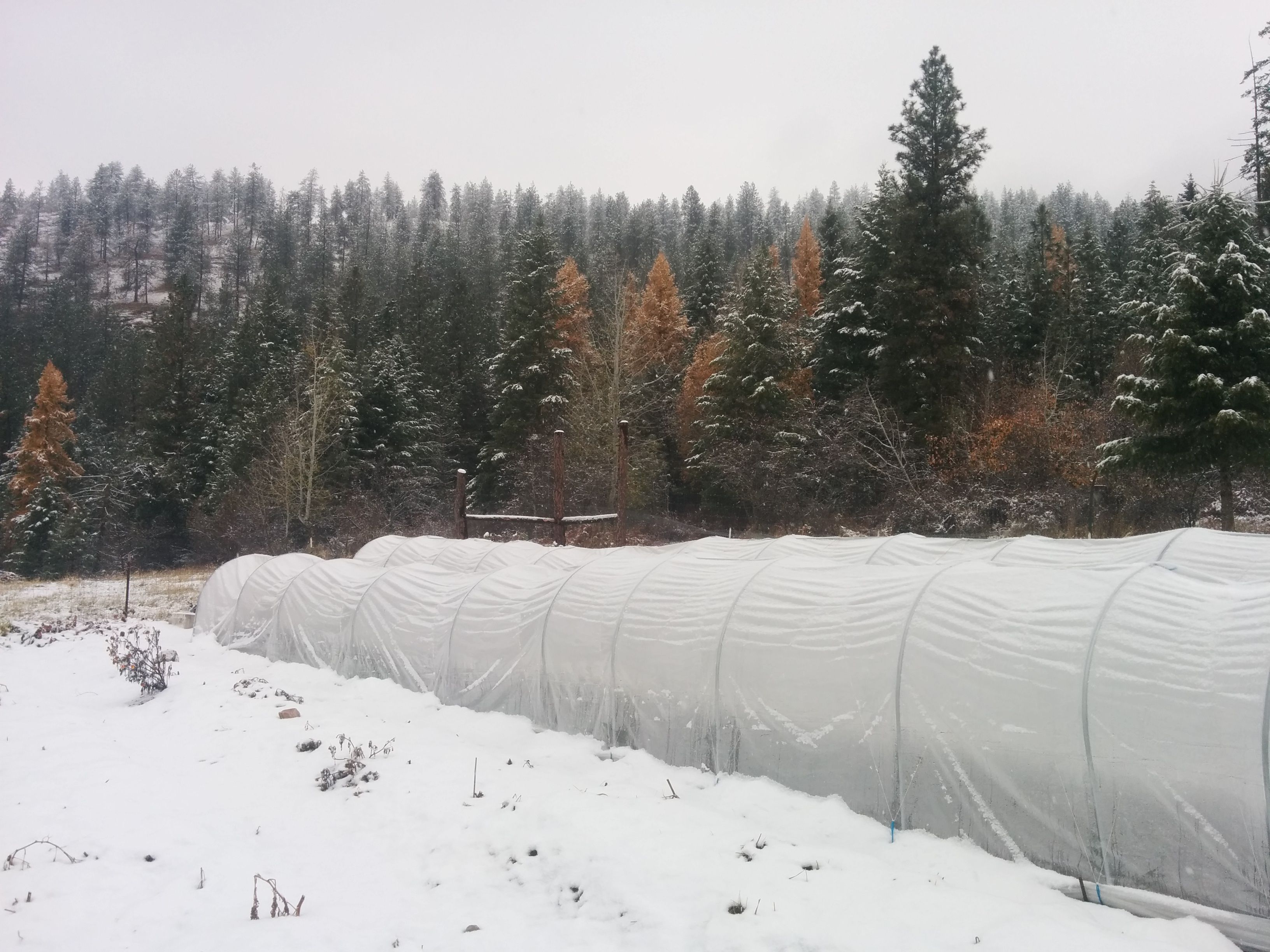
// EDIT
It occurred to me that I should also mention that the hoops don't prevent freezing temperatures within the hoops at night. They do a great job of amplifying the warmth of sunlight for more growth vigor and keeping frost off the plants during light frosts during the day. However, once the sun is down the temperature in the hoops will chill right down to the ambient temperature. So you still need to choose plants that are appropriately hardy to the night time temperatures during the shoulder seasons you wish to extend. There might be a way to use thermal mass to keep the temperature in the hoops warmer like you can do in a greenhouse, I just have not heard of anyone doing that in low tunnels.
//
Lessons Learned
While I don't like using plastic as a rule, poly is inexpensive and can give massive results in the shoulder season. Furthermore if only used in the colder parts of the shoulder it will have a much longer lifespan than if it was used year round. So I am hoping these row covers will last many years.
Since I had just moved in in late September I didn't have the luxury of planning my planting dates. Going forward I can see that having the plants at a pretty good stage of growth before it gets really cold and dark would yield the best results. So planting late summer or early fall would be ideal. If I had just planted a few weeks earlier I would have seen a huge difference because I would have been catching more of the longer growing days.
Anchor the hoops well if you have a chance of high winds!
The crisscrossed string method (linked above) is far superior to using clips because the plastic doesn't get damaged and it's really easy to lift up the plastic on one side and have it stay up and in place. It's a little more tedious to set up then using clips but it's well worth the effort.
Aside from the $60 poly sheet, everything was free. The seeds were shared, the steel hoops & re bar were borrowed, the strings were salvaged, and the garden access is part of a work trade. Not bad for an education in season extension and a bunch of delicious food!
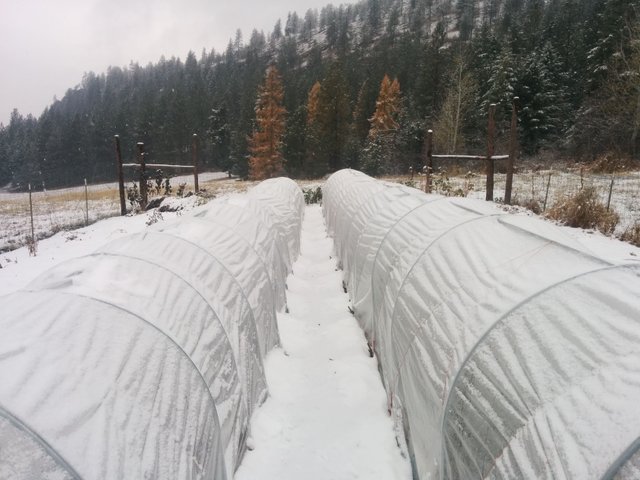
This post is very good and I accept and digest this paper easily .. thanks for .. knowledge of my friend
I appreciate your kind words @barzah :)
It's so nice to see the low tunnels can trap the heat from the ground to prevent your vegetables from being frozen by the cold outside. Very smart! And thank you for the link, too.
You're welcome :) I should update my post to clarify; the hoops don't prevent freezing at night. But they do amplify the sunlight and warmth during the day. So you still need plants that are hardy to the night time temperatures you expect to have.
It's great to be able to share and scavenge materials! When I tried to set up a similar, albeit a very much smaller tunnel, the steel hoop option, combined with quality plastic, clips and more amounted to about a 3 week average salary :) So now I'm looking at pre-bent rebar rods, as those are way cheaper.
Nice! At least you can use the metal materials year after year so it's an investment. I am definitely a fan of craigslist, etc and scrounging if you don't need things ASAP in order to save $.
These posts are so interesting, I can't believe you've got healthy bok choy flourishing in the midst of all that snow! And with only plastic to protect it!
Thank you for sharing your knowledge.
Glad you enjoyed it @calathea! Yeah it will be interesting to see how long they last and what survives for spring :)
For some reason, I can't explain it, I'm intimidated by the idea of doing a cold tunnel. Maybe it's because I can't believe that it's so simple and I'm missing something, and I'm afraid of wasting my time and seed. After seeing your success, maybe I'll set myself up to give it a go in the fall.
The main problems with cold tunnels manifest in the spring, when temperatures start to rise. At least in temperate climate, on some days it's so warm, the plants inside could and will die unless you keep the tunnel open for ventilation. However, those same days could be followed by a very cold, freezing nights. So you must close the tunnel.
In other words, it's not a 100% viable solution for an unattended scenario in a place with warm spring days!
What we do is keep both ends open, the plastic lifted and the opening covered with geofabric or similar breathable material. Cotton sheets work as well.
That's great advice! I will keep that in mind during the spring when we get those warm days :)
I can definitely recommend it for extending the seasons, earlier germination and faster growth in the shoulders. For food in the middle of a harsh winter, that might require more effort like mulch for protection or only choosing very hardy plants.
Thanks for the info! 😀
that bok choy looks AMAZING! and thanks for the tip - i had no idea that pvc could react with poly sheets & cause u.v. damage.
Yeah it blew my mind too because I have seen so many farmers and gardeners use PVC. I have also seen some aged poly get brittle in places and the longer I can keep the plastic from falling apart the better imo. Thanks for the compliments :)
Such a great post! The zone thing is so cool, I learned that this year as well. I want to try putting smaller tunnels inside the greenhouse next year to grow through the winter next year. I felt the same about plastic, but with proper care you could get years out of it. It is kind of unavoidable to use it in our growing zones sadly. You are doing so incredibly for moving in so late, I can't wait to see how well you do with a full growing season! You are going to have an amazing year!! <3
@karenfoster, thanks for your kindness! I am definitely looking forward to next year, but soaking up the rest of this year! Good luck with your greenhouse planning for next year :)